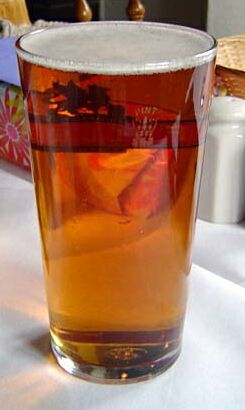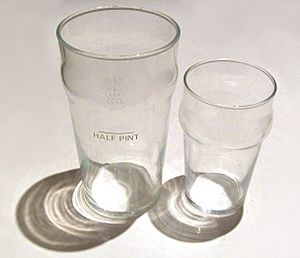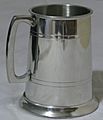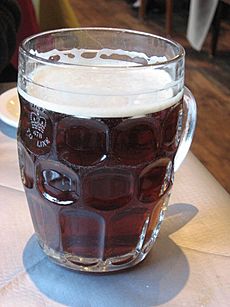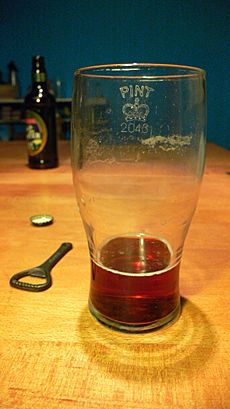Pint glass facts for kids
A pint glass is a special type of drinking glass. It's designed to hold a specific amount of liquid, usually beer or cider. In the United Kingdom, a pint glass holds about 568 milliliters (20 fluid ounces). In the United States, it holds about 473 milliliters (16 fluid ounces). These glasses are very common in pubs and restaurants around the world.
Contents
Different Shapes of Pint Glasses
Pint glasses come in several common shapes. Each shape has its own special features.
Conical Pint Glasses
Conical glasses are shaped like an upside-down cone. They are usually about 15 centimeters (6 inches) tall. The glass gets narrower towards the bottom. In the US, these are sometimes called "shaker pints." This is because they can be used as part of a cocktail shaker.
Nonik Pint Glasses
The nonik (pronounced "no-nick") glass is a bit like the conical one. But it has a bulge, or bump, a few inches from the top. This bulge helps you hold the glass better. It also stops glasses from getting stuck when stacked. Plus, it makes the rim stronger, so it's less likely to chip or "nick." This design was made popular after World War II.
Jug or Dimple Pint Glasses
Jug glasses, also called "dimple mugs," look more like a large mug with a handle. They have a bumpy, grid-like pattern on the outside. These dimples help you grip the glass, especially if it's wet. The design also makes the glass very strong. This helps it last longer, especially with lots of washing. These glasses are seen as more traditional today.
Tulip Pint Glasses
Tulip glasses are a more modern style. They are taller and usually flare out, or get wider, at the top. These glasses are often used for lager beers. Breweries sometimes put their logos or designs on them.
Can-Shaped Pint Glasses
Can-shaped glasses look just like a standard drink can. They have straight sides and a slightly inverted top edge. These glasses are less likely to tip over than conical ones. They are also lighter because they don't need a heavy base to stay stable.
History of Pint Glasses
Pint glasses became very popular in the United Kingdom in the early to mid-1900s. Before that, people mostly used tankards. Tankards were often made of metal like Pewter or ceramic.
Older Drinking Styles
Before pint glasses, people used different types of containers for their drinks:
- Decorative Toby jugs (from the mid-1700s).
- Pewter tankards (from the 1500s to 1900s).
- Ceramic tankards with handles (late 1800s to early 1900s).
- Glass tankards with 10 sides (1920s and 1930s).
-
A wooden tankard found on the 16th-century ship Mary Rose
Pint Glass Laws in the United Kingdom
In the United Kingdom, when you buy draught beer (beer from a tap), it must be sold in an exact Imperial pint measure. Laws in England, Scotland, and Northern Ireland make sure of this. One way to do this is by using special "certified" pint glasses.
These certified glasses have a special mark on them. Until 2007, they had a crown stamp. This showed that a government agency had checked and approved the glass. Now, many glasses have the letters CE etched on them. This means they have been certified by an approved company within the European Union. After the UK left the EU, a new mark called UKCA marking is being used. In 2021, it was announced that the crown mark would also return to pint glasses in the UK.
It is against the law to sell beer in glasses that haven't been measured and approved. Half-pint and two-thirds pint glasses are also available and follow the same rules.
Sometimes, a pint of beer might have a lot of foamy "head" on top. Industry rules allow up to 5% of the pint to be foam. However, some groups, like the Campaign for Real Ale (CAMRA), say this means drinkers get less liquid than they pay for. They suggest using "lined" glasses. These glasses have a line near the top, often marked "pint to line." The beer should be poured up to this line, with the foam forming above it. This helps ensure you get a full measure of liquid.
Pint Glasses in Other Countries
The size of a "pint" can be different in various countries.
- In Israel, a "pint" can vary a lot, usually between 360ml and 440ml.
- In the United States, a pint is 473ml. However, some glasses might only hold 473ml if filled right to the very top.
- In Canada, the law says a pint should be an Imperial pint (568ml). But sometimes, places might sell smaller US pints.
- In Australia, beer is measured in metric units. A common "pint" glass holds 570ml, which is close to an Imperial pint. In South Australia, a "pint" is 425ml, which is called a "schooner" in other parts of Australia.
- The Republic of Ireland uses the Imperial pint of 568ml. Their glasses also have special marks to show they've been checked.
| Type | Amount | Where it's used |
|---|---|---|
| Flemish pintje | 250 ml | Belgium |
| German Pintchen | ≈ 330 ml | Germany |
| Israel | 360–440 ml | Israel (varies) |
| South Australian pint | 425 ml | South Australia |
| US liquid pint | ≈ 473 ml | United States |
| Imperial pint | ≈ 568 ml | United Kingdom, Ireland, Canada |
| Australian pint | 570 ml | Australia |
Nucleated Pint Glasses
You might see pint glasses with small markings on the bottom. These markings are tiny pits or bumps. They help the gas in the beer escape more easily. This helps keep the foamy "head" on your beer for longer. Without these pits, the head might disappear in just a few minutes. These markings can be simple shapes or even part of a brand's logo.
Collecting Pint Glasses
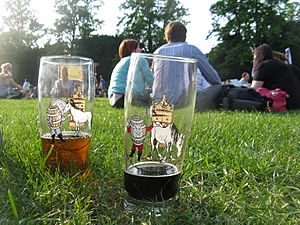
Many people enjoy collecting pint glasses. It's a fun way to remember visits to different places. For example, microbreweries (small breweries) and sports arenas often sell pint glasses with their logos. These logos are usually printed or engraved on the glass. People who love beer might travel far to visit breweries and try new beers. Collectors often display their pint glass collections at home. Beer festivals also often have special pint glasses made just for the event.
Stronger Pint Glasses for Safety
Sometimes, glass objects can break and cause harm. To make pint glasses safer, especially in busy places, some are made from stronger materials. For example, tempered glass is a type of safety glass that is much stronger than regular glass. If it does break, it shatters into small, less sharp pieces. This helps to reduce the risk of injury. Plastic glasses are also used at large events or in places where safety is a big concern.


